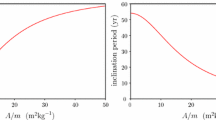Abstract
We use a simple model of the dynamics of a narrow-eccentric ring, to put some constraints on some of the observable properties of the real systems. In this work we concentrate on the case of the ‘Titan ringlet of Saturn’.
Our approach is fluid-like, since our description is based on normal modes of oscillation rather than in individual particle orbits. Thus, the rigid precession of the ring is described as a global m = 1 mode, which originates from a standing wave superposed on an axisymmetric background. An integral balance condition for the maintenance of the m=1 standing-wave can be set up, in which the differential precession induced by the oblateness of the central planet must cancel the contributions of self-gravity, the resonant satellite forcing and collisional effects. We expect that in nearly circular narrow rings dominated by self-gravity, the eccentricity varies linearly across the ring. Thus, we take a first order expansion and we derive two integral relationships from the rigid-precession condition. These relate the surface density of the ring with the eccentricity at the centre, the eccentricity gradient and the location of the secular resonance.
These relationships are applied to the Titan ringlet of Saturn, which has a secular resonance with the satellite Titan in which the ring precession period is close to Titan’s orbital period. In this case, we estimate the mean surface density and the location of the secular resonance.
Similar content being viewed by others
References
N. Borderies P. Goldreich S. Tremaine (1983) ArticleTitle‘The dynamics of elliptical rings’ Astron. J 88 1560–1568 Occurrence Handle10.1086/113446
E. I. Chiang P. Goldreich (2000) ArticleTitle‘Apse Alignment of Narrow Eccentric Planetary Rings’ Astrophys. J 540 IssueID2 1084–1090 Occurrence Handle10.1086/309372
S. F. Dermott C. D. Murray (1980) ArticleTitle‘The origin of the eccentricity gradient and the apse alignment of the epsilon-ring of Uranus’ Icarus 43 338–349 Occurrence Handle10.1016/0019-1035(80)90179-7
French, R. G., Nicholson, P. D., Porco, C. and Marrouf, E. A.: 1984, ‘Dynamics and structure of the uranian rings’, In, Planetary Rings, Richard Greenberg and Andre Brahic (eds.), University of Arizona press, Tucson, Arizona, pp. 513–561.
P. Goldreich C. C. Porco (1987) ArticleTitle‘Shepherding of the uranian rings. II. Dynamics’ Astron. J 93 730–737 Occurrence Handle10.1086/114355
P. Goldreich S. Tremaine (1979) ArticleTitle‘Precession of the epsilon ring of Uranus’ Astron. J 84 1638–1641 Occurrence Handle10.1086/112587
P. Goldreich S. Tremaine (1981) ArticleTitle‘The origin of the eccentricities of the rings of Uranus’ Astrophys. J 243 1062–1075 Occurrence Handle10.1086/158671
A. L. Graps M. R. Showalter J. J. Lissauer D.M. Kary (1995) ArticleTitle‘Optical depths profiles and streamlines of the uranian (epsilon) ring’ Astron. J 109 2262–2273 Occurrence Handle10.1086/117451
N. R. Lebovitz (1967) Astrophys J. 150 203–212 Occurrence Handle10.1086/149321
P. Y. Longaretti N. Rappaport (1995) ArticleTitle‘Viscous overstabilities in dense narrow planetary rings’ Icarus 116 376–396 Occurrence Handle10.1006/icar.1995.1131
C. D. Murray S. Dermott (1999) Solar System Dynamics Cambridge University press Cambridge, United Kingdom
I. Mosqueira P. R. Estrada (2002) ArticleTitle‘Apse alignment of the uranian rings’ Icarus 158 IssueID2 545–556 Occurrence Handle10.1006/icar.2002.6878
Moulton, F. R.: 1935, An Introduction to Celestial Mechanics. Ed: The Macmillan company, London.
Papaloizou, J. C. B. and Melita, M. D.: 2005, Icarus, in press.
C. Porco P. D. Nicholson N. Borderies G. E. Danielson P. Goldreich J. B. Holberg A. L. Lane (1984) ArticleTitle‘The eccentric Saturnian rings at 1.29RS and 1.45RS‘ Icarus 60 1–16 Occurrence Handle10.1016/0019-1035(84)90134-9
F. H. Shu C. Yuan J. J. Lissauer (1985) ArticleTitle‘Nonlinear spiral density waves: An inviscid theory’ Astrophys. J 291 356–376 Occurrence Handle10.1086/163075
G. L. Tyler V. R. Eshleman D. P. Hinson E. A. Marouf R. A. Simpson D. N. Sweetnam J. D. Anderson J. K. Campbell G. S. Levy G. F. Lindal (1986) ArticleTitle‘Voyager 2 radio science observations of the uranian system atmosphere, rings, and satellites’ Science 233 79–84
Author information
Authors and Affiliations
Corresponding author
Rights and permissions
About this article
Cite this article
Melita, M.D., Papaloizou, J.C.B. Resonantly Forced Eccentric Ringlets: Relationships Between Surface Density, Resonance Location, Eccentricity And Eccentricity-Gradient. Celestial Mech Dyn Astr 91, 151–171 (2005). https://doi.org/10.1007/s10569-004-4624-x
Received:
Accepted:
Issue Date:
DOI: https://doi.org/10.1007/s10569-004-4624-x




